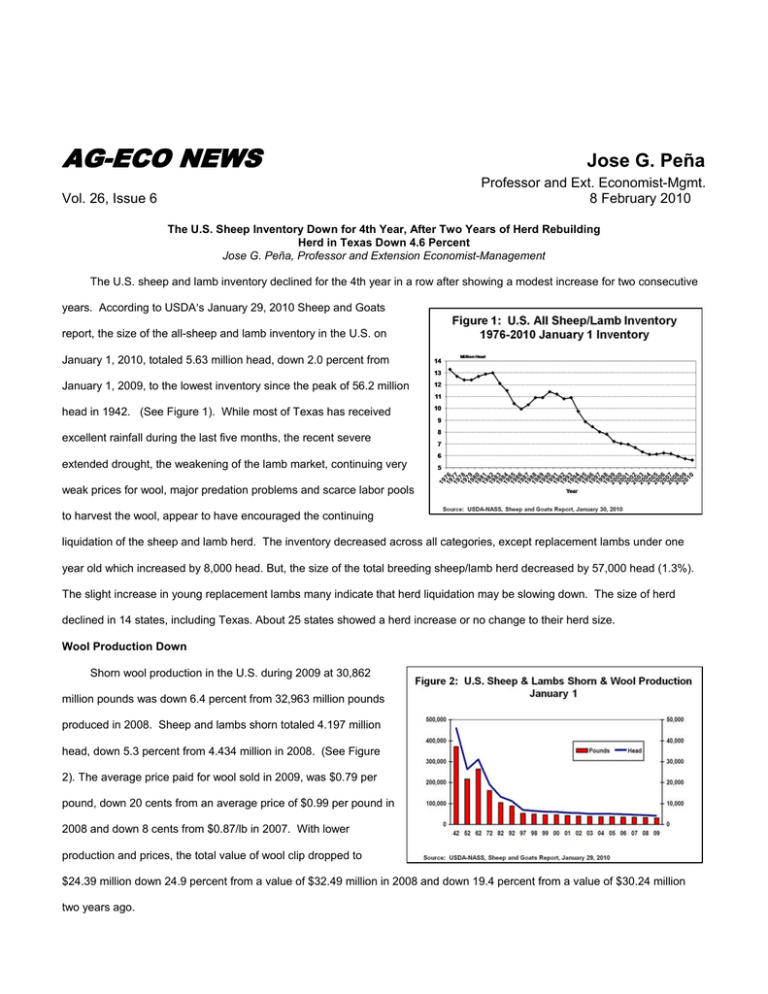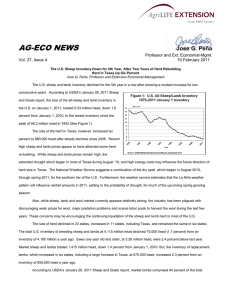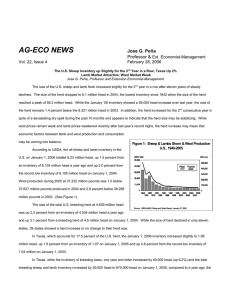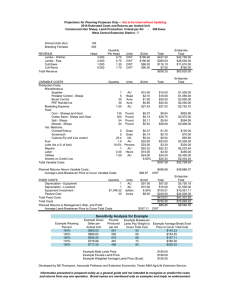AG-ECO NEWS Jose G. Peña
advertisement

AG-ECO NEWS Jose G. Peña Professor and Ext. Economist-Mgmt. 8 February 2010 Vol. 26, Issue 6 The U.S. Sheep Inventory Down for 4th Year, After Two Years of Herd Rebuilding Herd in Texas Down 4.6 Percent Jose G. Peña, Professor and Extension Economist-Management The U.S. sheep and lamb inventory declined for the 4th year in a row after showing a modest increase for two consecutive years. According to USDA=s January 29, 2010 Sheep and Goats report, the size of the all-sheep and lamb inventory in the U.S. on January 1, 2010, totaled 5.63 million head, down 2.0 percent from January 1, 2009, to the lowest inventory since the peak of 56.2 million head in 1942. (See Figure 1). While most of Texas has received excellent rainfall during the last five months, the recent severe extended drought, the weakening of the lamb market, continuing very weak prices for wool, major predation problems and scarce labor pools to harvest the wool, appear to have encouraged the continuing liquidation of the sheep and lamb herd. The inventory decreased across all categories, except replacement lambs under one year old which increased by 8,000 head. But, the size of the total breeding sheep/lamb herd decreased by 57,000 head (1.3%). The slight increase in young replacement lambs many indicate that herd liquidation may be slowing down. The size of herd declined in 14 states, including Texas. About 25 states showed a herd increase or no change to their herd size. Wool Production Down Shorn wool production in the U.S. during 2009 at 30,862 million pounds was down 6.4 percent from 32,963 million pounds produced in 2008. Sheep and lambs shorn totaled 4.197 million head, down 5.3 percent from 4.434 million in 2008. (See Figure 2). The average price paid for wool sold in 2009, was $0.79 per pound, down 20 cents from an average price of $0.99 per pound in 2008 and down 8 cents from $0.87/lb in 2007. With lower production and prices, the total value of wool clip dropped to $24.39 million down 24.9 percent from a value of $32.49 million in 2008 and down 19.4 percent from a value of $30.24 million two years ago. Lamb Prices Down Wool, lamb and mutton (meat from sheep one-year old or older) are the products of the sheep industry. Feeder lamb prices improved during spring 2008 and 2009, but remain significantly below 2005's record highs (see figure 3). Relatively weak lamb prices, weak wool prices and the extended dry weather, together with high feed/energy costs have encouraged the continuing liquidation of the U.S. Sheep herd. In an attempt to provide some market stability, USDA=s Risk Management Agency implemented a Livestock Risk Protection-(LRP) Lamb program in September 2007. The government sponsored and subsidized program allows producers and feeders to purchase insurance to protect them against unexpected declines in lamb prices. The Pasture, Rangeland, Forage insurance program remains available in large portion of Texas. Imports U.S. lamb and mutton supplies dropped slightly during the past two years, but have remained fairly stable for the last 30 years (annual average of about 369 million pounds since 1998), Imports rose rapidly in the mid-1990's to fill the gap as U.S. lamb production decreased and as lamb imports quickly found consumer acceptance in the U.S. (See Figure 4). Almost all of the U.S. lamb imports come from Australia and New Zealand. Imports account for about one-half of total U.S. domestic lamb and mutton consumption. Exports The U.S. exports small quantities of lamb compared to its imports. Exports have increased during recent years, but the balance of trade weighs heavily on imports. Most of the U.S. mutton is exported to Mexico in the form of old (cull) ewes. Another key trading location for exports is Canada. Per Capita Consumption After dropping significantly to record lows in the mid-90's, U.S. Lamb and Mutton per capita consumption appears to be stabilizing at about 1.0 pound. (See Figure 5). Texas Inventory Down In Texas, the January 1, 2010 all-sheep and lamb inventory decreased to 830,000 head, down 4.5 percent from an inventory of 870,000 head on January 1, 2009. The Southwest Texas region, where most of the sheep and lambs reside, experienced a severe extended drought during January 2005- August 2009. While the inventory of replacement lambs in Texas increased by 5,000 head on Jan 1, 2010, the size of the total breeding decreased by 10,000 head (1.5%), with most of the decrease coming out of the breeding ewe inventory. The inventory of 6.1 million head on January 1, 1961 in Texas alone was larger than the size of the total current U.S. inventory. Texas remains the leading state with 14.1 percent of the total U.S. herd, compared to 15.1 percent a year ago and 16.1 percent on Jan. 1, 2008. Appreciation is expressed to Dr. Rick Machen, Extension Livestock Specialist for his contribution and to review of this article.





